When you’re working with precious metal clay, texture becomes your secret weapon for transforming ordinary pieces into extraordinary works of art. You’ll discover that even the simplest pendant or ring can capture light differently, tell a story, and command attention when you add surface variation. The beauty lies in how texture doesn’t just change appearance—it fundamentally shifts how people interact with your jewelry, creating pieces that beg to be touched and examined more closely.
Enhanced Visual Appeal and Artistic Expression
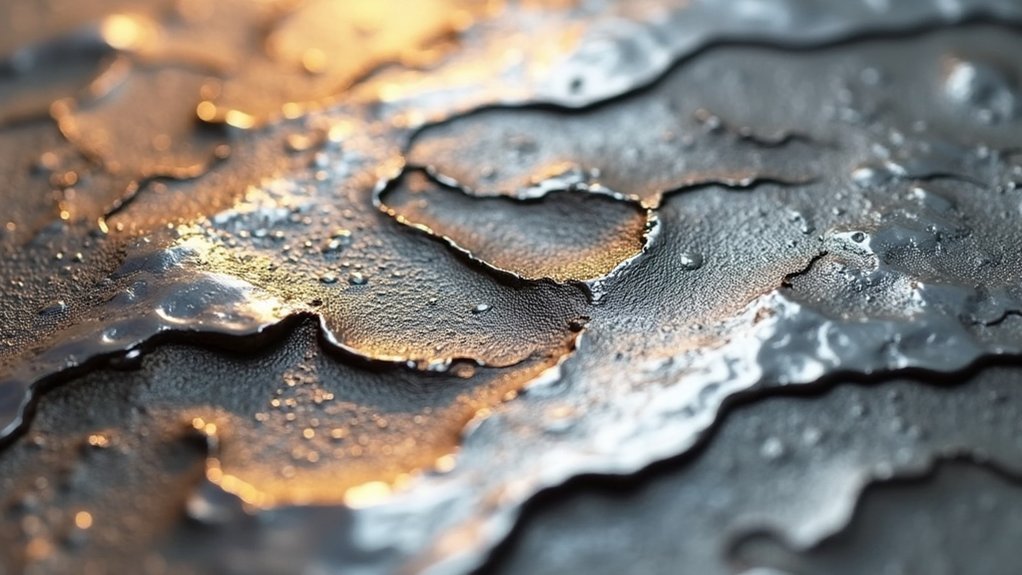
When you apply texture to precious metal clay, you’ll instantly transform flat, ordinary surfaces into enchanting designs that play with light and shadow. This simple technique adds depth and character that catches the eye from every angle, creating visual interest that plain surfaces simply can’t achieve.
Texture releases your artistic expression, letting you craft metal clay jewelry that truly reflects your personal style and creative vision.
Through texture, your metal clay becomes a canvas for personal expression, transforming simple jewelry into distinctive artistic statements.
You’re no longer limited to basic forms – instead, you can explore countless design possibilities that showcase your unique aesthetic.
Whether you’re drawn to organic patterns inspired by nature or prefer bold geometric designs, texture becomes your creative voice. Each piece you create tells a story through its surface, elevating your work from simple jewelry to meaningful art that resonates with both maker and wearer.
Creating Depth and Dimension in Jewelry Designs
When you add texture to your precious metal clay pieces, you’re transforming flat, ordinary surfaces into engaging focal points that command attention.
The interplay between raised and recessed areas creates visual depth that makes light dance across your jewelry’s surface in unexpected ways.
You’ll find that even simple texturing techniques can completely revolutionize how viewers perceive and interact with your designs.
Visual Impact Enhancement
Although flat jewelry designs have their place, transforming precious metal clay with texture creates dramatic visual impact that elevates your pieces from simple to stunning.
When you apply various textures to PMC, you’re creating dynamic surfaces that play with light and shadow, instantly drawing attention to your work.
The right textures can completely transform how people perceive your jewelry:
- Light reflection – Textured surfaces catch and redirect light at different angles
- Visual depth – Raised and recessed areas create the illusion of dimensionality
- Eye movement – Patterns guide the viewer’s gaze across your piece
Whether you’re using natural elements like leaves or household items like sponges, each texture introduces unique patterns that make your jewelry more engaging and visually compelling.
Surface Design Transformation
Surface design transformation through texturing turns your precious metal clay from a blank canvas into a multidimensional masterpiece. When you roll texture mats over your PMC, you’re creating defined patterns that catch and reflect light differently across the surface. This process transforms flat, ordinary metal into intricate landscapes of shadow and highlight.
| Texture Source | Design Effect | Light Interaction |
|---|---|---|
| Natural leaves | Organic patterns | Soft shadows |
| Bark impressions | Rustic textures | Deep contrast |
| Fabric weaves | Linear designs | Subtle highlights |
| Household mesh | Geometric grids | Sharp definition |
| Custom stamps | Unique motifs | Dramatic depth |
Each texture creates its own visual story, adding character that makes your jewelry stand out. You’ll find that textured surfaces engage viewers longer, inviting them to explore every detail of your creation.
Transforming Simple Shapes Into Complex Art Pieces
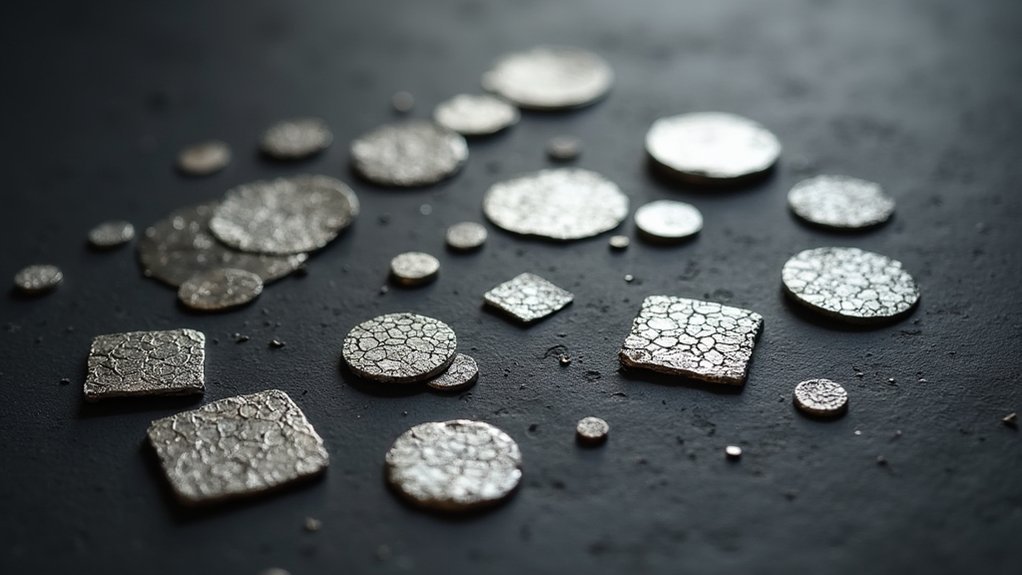
Three fundamental techniques can transform your basic precious metal clay shapes into sophisticated art pieces that enchant viewers.
When you apply textures to simple PMC forms, you’re adding visual complexity that creates depth and character. Your plain circles, squares, or ovals become dynamic focal points through strategic texture application.
The key methods for achieving this transformation include:
- Rolling texture stamps directly onto flattened clay surfaces
- Pressing everyday objects into the clay to create unique impressions
- Layering multiple textures to build intricate pattern combinations
You’ll discover that texture stamps offer precise control over pattern placement, while household items provide unlimited creative possibilities.
Each imprint adds intricate details that turn uniform shapes into enchanting jewelry elements, allowing you to express your personal artistic style effectively.
Adding Tactile Interest and Surface Variation
Tactile elements in your precious metal clay work create an irresistible invitation for viewers to engage with your pieces on multiple sensory levels.
When you add texture to smooth surfaces, you’re transforming flat jewelry into dimensional art that begs to be touched. The contrast between raised and recessed areas creates surface variation that catches light differently, adding visual depth and movement to your designs.
You can achieve stunning results using texture sheets, which offer consistent patterns, or experiment with everyday objects for unique impressions.
This interplay of textures makes each piece more engaging than smooth alternatives. The tactile quality distinguishes your handcrafted work from mass-produced jewelry, while the surface variation guarantees your pieces capture attention through both visual appeal and the irresistible urge to explore through touch.
Personalizing Jewelry With Unique Pattern Elements
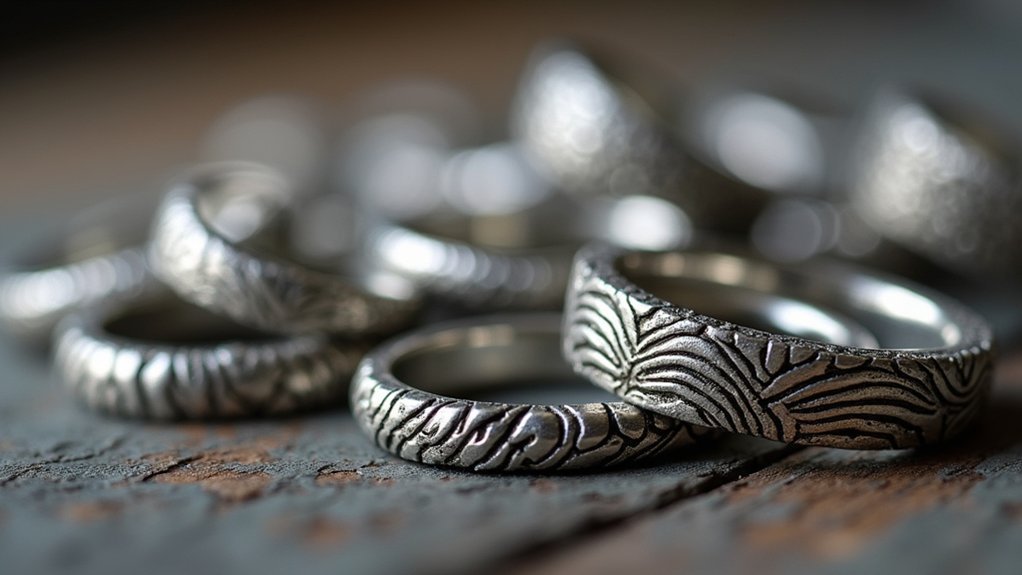
When you incorporate objects that hold personal meaning into your precious metal clay texturing, you’re creating jewelry that tells your unique story. Household items and natural materials from your environment become powerful tools for capturing impressions that reflect your experiences and style.
Texturing precious metal clay transforms ordinary pieces into bespoke collections where each item carries distinct character. You can easily achieve detailed impressions that would be challenging with traditional metalworking techniques, making personalization accessible and straightforward.
Consider these approaches for unique pattern elements:
- Custom molds – Capture specific designs for repeatable or varied patterns
- Environmental textures – Use leaves, shells, or fabric from meaningful places
- Personal artifacts – Press coins, lace, or heirloom items into clay
This process guarantees every piece becomes individually expressive.
Professional Finishing Techniques for Higher Value
Professional finishing techniques separate amateur precious metal clay work from pieces that command premium prices. You’ll transform your textured pieces into professional-quality jewelry through strategic sanding, polishing, and liquid gold applications. Multiple firing processes—starting with bisque firing followed by high-temperature firing—create durable, wear-resistant pieces that maintain their beauty over time.
| Technique | Purpose | Market Impact |
|---|---|---|
| Sanding & Polishing | Creates high shine on textured surfaces | Increases perceived value |
| Multiple Firing | Enhances durability and finish quality | Guarantees longevity |
| Gemstone Addition | Elevates design appeal | Commands premium pricing |
| Clean Edge Definition | Shows attention to detail | Attracts serious buyers |
| Liquid Gold Application | Adds luxurious finish | Considerably boosts value |
Your texture work becomes truly valuable when you’re meticulous about clean edges and defined patterns—details that separate professional craftsmanship from hobby-level work.
Exploring Natural and Organic Design Inspirations
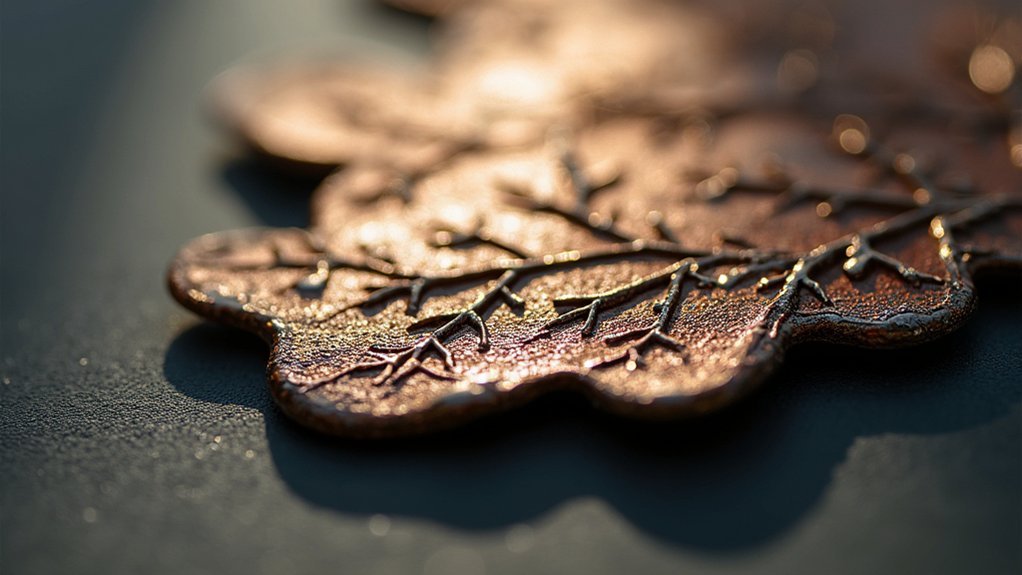
You’ll find nature offers an unlimited collection of textures right outside your door, from tree bark’s rugged patterns to delicate leaf veins that can transform your metal clay pieces.
Everyday organic materials like dried pasta, citrus peels, and fresh herbs become powerful design tools when you press them directly into your clay before firing.
As seasons change, you’ll discover new texture opportunities with different plants and materials, keeping your creative inspiration fresh and constantly evolving.
Nature’s Endless Texture Library
Since nature provides an unlimited supply of texturing materials right outside your door, you can create stunning impressions in precious metal clay without spending a penny on specialized tools.
Natural elements like leaves, twigs, and tree bark offer authentic organic textures that transform ordinary metal clay into extraordinary jewelry pieces.
Your local environment becomes a treasure trove for creative exploration:
- Seasonal Collection: Gather frost patterns, fallen leaves, and seasonal botanicals for time-sensitive texture opportunities.
- Beachcombing Adventures: Collect shells and weathered rocks that imprint distinctive coastal patterns into your clay.
- Kitchen Experimentation: Use dried pasta, citrus peels, and herbs that burn away cleanly during firing.
Each season brings fresh possibilities, from delicate herb impressions to bold bark textures, ensuring your designs remain dynamic and inspired.
Organic Materials as Tools
Everything around you can become a texturing tool when working with precious metal clay, transforming ordinary objects into artistic instruments that create extraordinary surface designs. Organic materials offer unlimited possibilities for creating unique impressions that capture nature’s intricate patterns.
| Material Type | Examples | Result After Firing |
|---|---|---|
| Leaves & Botanicals | Ferns, rose petals, grass | Detailed vein patterns |
| Tree Materials | Bark, twigs, seed pods | Rustic, natural textures |
| Food Items | Dried pasta, citrus peels | Burns away, leaves impression |
| Marine Elements | Seashells, coral fragments | Ocean-inspired surfaces |
| Nuts & Seeds | Walnut shells, acorns | Organic geometric patterns |
These organic materials burn away during firing, leaving only their textural impression. You’ll discover that collecting environmental textures encourages sustainable artistic practices while enabling creative experimentation that traditional tools can’t achieve.
Seasonal Inspiration Opportunities
As each season unfolds, nature presents a rotating gallery of textures that can transform your precious metal clay work into time-capsule art pieces.
Spring’s fresh buds and delicate blossoms inspire soft, intricate designs that capture renewal’s essence.
Summer beachcombing yields shells and seaweed, creating organic patterns that enhance your metal clay’s coastal appeal.
Autumn delivers dried leaves and seed pods, adding rustic textures perfect for earth-toned jewelry.
Winter’s frost patterns and tree bark textures offer unique impressions for seasonal interpretations.
Consider these seasonal texture-hunting strategies:
- Explore local parks during peak seasonal changes for diverse plant and stone textures
- Document interesting patterns with photos before pressing them into your metal clay
- Create seasonal jewelry collections that reflect each time period’s distinctive natural elements
Achieving Detailed Surface Effects Without Advanced Skills
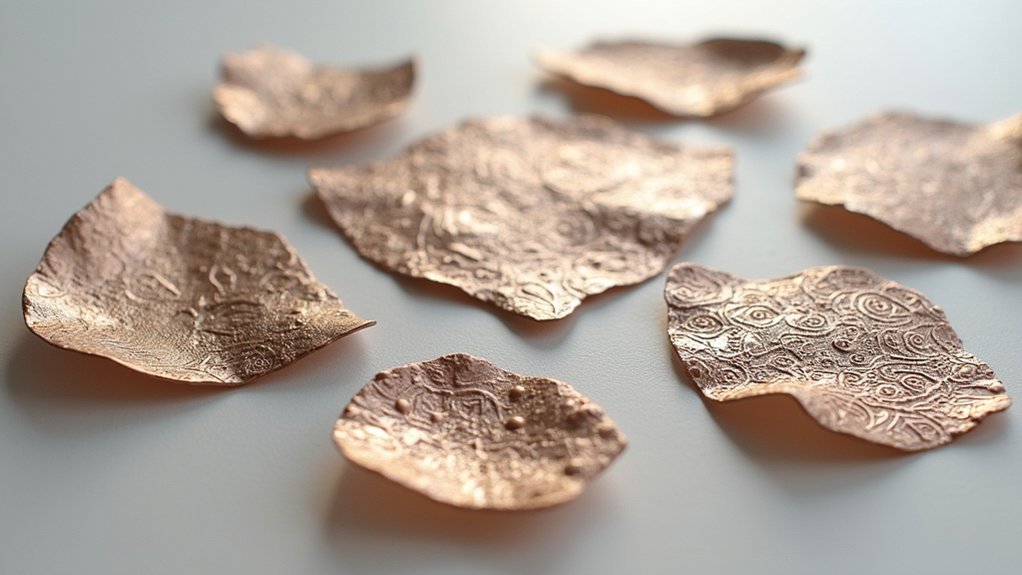
When you’re working with precious metal clay, texture becomes your secret weapon for creating sophisticated-looking jewelry without mastering complex metalworking techniques.
Texturing eliminates the need for advanced skills like soldering or forging while producing intricate surface designs that rival professional work.
You can achieve stunning effects using simple texture mats or everyday household items for imprinting. These tools create unique patterns quickly and easily, transforming basic shapes into eye-catching pieces with remarkable depth and character.
Texture also serves as a clever disguise for minor clay imperfections, ensuring your finished piece looks polished and intentional.
Building Texture Libraries for Consistent Design Themes
You’ll want to organize your texture sources into clear categories like commercial tools, household items, and natural materials to streamline your creative process.
Create physical sample cards that show how each texture translates onto PMC, making it easy to compare options when planning new pieces.
Document everything digitally with photos and notes about pressure, clay thickness, and firing results so you can replicate successful textures consistently.
Categorizing Texture Sources
Building an organized texture library transforms your precious metal clay work from random experimentation to purposeful design creation.
You’ll find that categorizing your texture sources into distinct groups creates the foundation for cohesive, professional-looking pieces. Effective categorization helps you develop signature styles while maintaining design consistency across multiple projects.
When you group textures by their visual characteristics, you can quickly identify which ones complement each other and support your artistic vision.
Consider organizing your texture collection using these three main categories:
- Organic textures – leaves, bark, shells, stones, and other natural materials
- Geometric textures – fabric weaves, architectural elements, tiles, and structured patterns
- Abstract textures – artistic surfaces, experimental materials, and unique household items
This systematic approach streamlines your creative process and guarantees each piece maintains thematic coherence.
Creating Physical Samples
Since texture categories alone won’t reveal how materials translate into fired metal clay, you must create physical sample cards that capture the actual impression each source produces.
Press your molding material against various textures, then fire these samples to see exactly how they’ll look in your finished pieces. This process eliminates guesswork and prevents disappointing results when working on important projects.
Label each sample card with the source material and firing conditions used. Store them systematically so you can quickly locate specific textures when inspiration strikes.
These tangible references become invaluable for maintaining consistency across multiple pieces and developing your signature style. You’ll also discover which textures work best for different clay thicknesses and project types through hands-on testing.
Digital Documentation Methods
Three essential components form the backbone of an effective digital texture library: extensive visual records, detailed categorization systems, and searchable metadata.
You’ll want to photograph each texture sample alongside detailed descriptions, creating a thorough database that guarantees consistent design themes across your PMC projects.
Your digital texture library should include:
- Categorization by type and source – Natural objects, household items, manufactured textures
- Application technique notes – Rolling methods, pressure requirements, firing considerations
- Project tracking metadata – Creation dates, design evolution notes, compatibility records
Use spreadsheets or specialized software to organize your findings.
Regular updates with new discoveries keep your creative possibilities expanding.
This systematic approach transforms random texture experiments into a powerful design resource that streamlines your jewelry-making process.
Maximizing Creative Potential With Minimal Tool Investment
When you’re working with Precious Metal Clay, you don’t need to invest in expensive specialty tools to create stunning textured pieces. Your kitchen drawer holds countless texturing opportunities – from forks creating parallel lines to mesh strainers producing intricate patterns. This accessibility transforms jewelry making into an affordable art form where creativity trumps costly equipment.
| Household Item | Texture Created | Cost |
|---|---|---|
| Pasta strainer | Fine mesh pattern | $0 |
| Fabric lace | Delicate floral design | $0 |
| Plastic bottle cap | Circular ridges | $0 |
| Kitchen sponge | Organic stippling | $0 |
| Corrugated cardboard | Linear waves | $0 |
You’ll discover that experimenting with everyday objects opens up unlimited design possibilities. This approach encourages innovation while keeping your budget intact, proving that outstanding textured jewelry emerges from resourcefulness rather than expensive tools.
Frequently Asked Questions
Why Is PMC Being Discontinued?
You’re seeing PMC discontinued because manufacturers face rising production costs and raw material sourcing challenges. You’ll find artists choosing modern alternatives and sustainable materials, while educational programs adapt to these industry shifts.
What Are the Disadvantages of Precious Metal Clay?
You’ll face higher costs than traditional metals, unpredictable shrinkage during firing, moisture sensitivity requiring controlled environments, expensive specialized tools, and limited texture options that may restrict your creative vision.
Is Precious Metal Clay Being Discontinued?
You don’t need to worry about PMC being discontinued. It’s still widely available through retailers and remains popular among artists. While formulations may evolve, the precious metal clay category continues thriving.
What Is the Difference Between PMC and Art Clay?
PMC and Art Clay differ in their binders and metal content. You’ll notice PMC has smoother texture while Art Clay offers more variety in metals like bronze. They’ve got different shrinkage rates and firing requirements too.
In Summary
You’re not just making jewelry—you’re crafting stories through texture. When you embrace these techniques, you’ll transform ordinary metal clay into extraordinary wearable art that captures light, invites touch, and reflects your unique vision. Don’t settle for flat, lifeless surfaces when you can create pieces that speak volumes about your creativity. Start texturing today, and you’ll discover possibilities you never knew existed within your artistic reach.

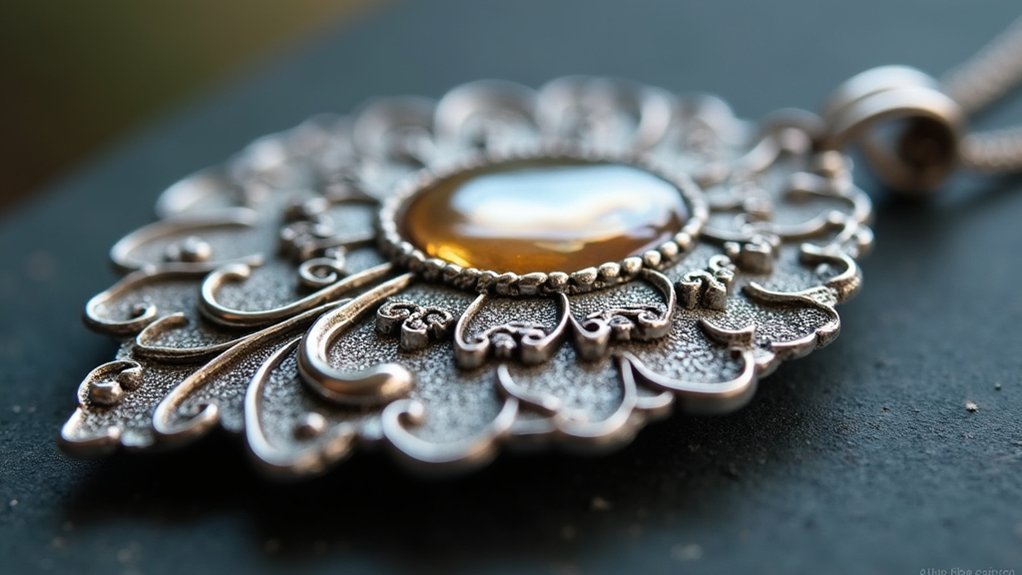



Leave a Reply